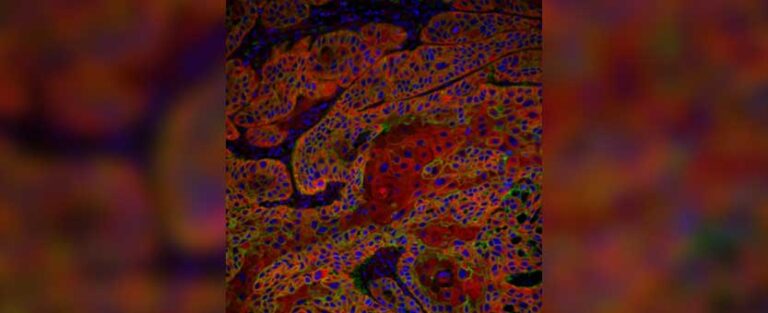
Nuclear staining of triple negative breast cancer cells. / Laura Pascual Reguant / Center for Genomic Regulation.
Experiments with mice reveal a potential new treatment that could transform triple-negative breast cancer into a controllable disease. Researchers from the Center for Genomic Regulation and Vall d’Hebron point out that there is still work to be done before reaching patients, but that each advance in understanding the mechanisms of this disease constitutes good news.
Researchers from the Center for Genomic Regulation and the Vall d’Hebron Institute of Oncology have shown that the simultaneous inhibition of two different proteins may represent a new strategy to confront triple negative breast cancer, the most aggressive and resistant form of breast cancer. to drugs. The findings are published today in the journal EMBO Molecular Medicine.
Breast cancer is the most diagnosed type of cancer and the fourth most common cause of cancer-related death in women, with more than two million cases worldwide and 685,000 deaths in 2020.
About one in seven (15%) of these cases are a highly aggressive form of the disease known as triple-negative breast cancer. The prognosis of this type of tumor is poor, because the disease is highly resistant to existing treatments, since its cells lack the receptors targeted by breast cancer drugs.
Recently, the LOXL2 enzyme has been shown to promote the growth of triple-negative breast cancer. A team led by Sara Sdelci, from the Center for Genomic Regulation, and Sandra Peiró, together with the Non-Colorectal Gastrointestinal Cancer Translational Research Group of the Vall d’Hebron Oncology Institute, has carried out several analyzes to evaluate the suitability of the enzyme as a biomarker to predict the success of treatments.
They found that LOXL2 expression alone predicts the outcomes of drugs that target BRD4, a cancer-promoting protein. Prompted by their findings, the researchers conducted further experiments to evaluate whether the LOXL2 and BRD4 proteins might be collaborating to help triple-negative breast cancer cells proliferate.
Several experiments demonstrated that LOXL2 interacts with a version of BRD4 within the cell nucleus. The researchers also demonstrated that this interaction changes the expression of certain genes that help the proliferation of triple-negative breast cancer cells. Inhibiting both proteins at the same time disrupted these interactions and helped slow cancer growth in cell cultures (in vitro) and in three different mouse models (in vivo).
“We have delved deeper at the molecular level to understand how triple-negative breast cancer cells grow and have discovered a new mechanism that can be exploited for therapeutic purposes. It’s exciting, because a dual-targeting strategy targeting both proteins could be combined with other treatments and transform triple negative breast cancer, from being a disease with an unfavorable prognosis to a controllable one,” says Laura Pascual Reguant, first author of the study and postdoctoral researcher at the Center for Genomic Regulation, in Barcelona.
The findings have important implications for an experimental class of drugs known as BET inhibitors, which have shown promising results in the fight against triple-negative breast cancer. BET inhibitors act by compromising the function of BRD4, but have not reached the clinic because triple-negative breast cancer cells acquire resistance to the treatment. The authors of the study believe that the simultaneous modulation of BRD4 and LOXL2 could help overcome this resistance.
The next challenge will be to find a way to safely and effectively target both proteins at the same time. One possible strategy is to combine different inhibitors. BET inhibitors are already targeting different versions of BRD4 in 30 clinical trials, five of which target triple-negative breast cancer. LOXL2 inhibitors also exist, but their safety and effectiveness in cancer treatment have not been explored. The combination of both inhibitors has not been tested.
“More work needs to be done before our findings benefit patients, but any progress in understanding the mechanisms of this highly aggressive disease is good news. As we continue to unravel the mechanisms that explain how triple-negative breast cancer proliferates , the health challenges that arise could be more manageable than we thought,” concludes Sdelci.
Reference: Sdelci, S. et al. “Interactions between BRD4S, LOXL2, and MED1 drive cell cycle transcription in triple-negative breast cancer.” EMBO Molecular Medicine (2023)
Source: CRG
https://www.agenciasinc.es/Noticias/Una-double-attack-strategy-stops-resistant-breast-cancer




